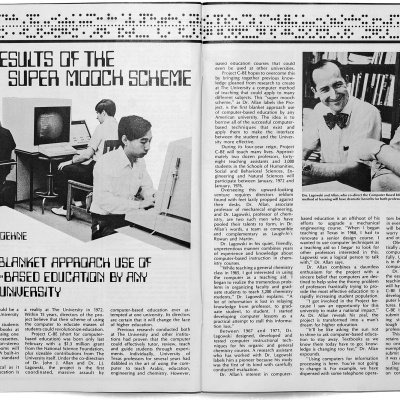How the Texas Exes’ Founding Shaped the State’s History

It’s a story nearly as old as the state of Texas itself, dating back to when the university was just a 40-acre piece of land, and Old Main grandly stood upon the highest point on campus.
The lone building had just been constructed, following the creation of UT Austin’s charter in 1881—signed into action by Gov. Oran Roberts, who was known as “The Old Alcalde” (and serves as this magazine’s namesake). As it still reads today, the Texas constitution officially declared the establishment and support of “a university of the first class.”
And so it was.
The university’s fledgling days are indisputably tied to the Texas Exes’ founding—a story full of heated politics, grit, and immense pride. It’s about Longhorns coming together in the name of loyalty to their alma mater, building something powerful, and creating change in favor of the university. When you’re sipping a beer at the Etter-Harbin Alumni Center at a Saturday tailgate or halfway around the world, watching Texas football with your chapter, it’s easy to forget the organization’s long-standing history within the state. But since the first class of students graduated in 1885, the Texas Exes has been along for the ride.
When The University of Texas officially opened on Sept. 15, 1883, campus was made up of about 200 students and eight faculty members. “There was much in the new atmosphere of a young, vigorous, and rapidly growing state,” wrote UT’s first-ever chairman of the faculty, J.W. Mallet, for a reminiscence of the university’s first year in the inaugural Alcalde in 1913. “And in the hopes and plans for the new institutions of learning, to inspire one with enthusiasm and interest.”
Two years after UT’s first day as a working institution, the university celebrated its first graduating class—and the UT Alumni Association, as the Texas Exes was first known, was born. On June 17, 1885, 34 new graduates came together to form a group to stay connected and express their pride in the university. At this point, the alumni organization was an extension of the university. And it stayed that way for more than 30 years. For the majority of that time, the alumni association—which eventually changed its legal name to the Ex-Students’ Association of The University of Texas—had no home until 1913, when the university gave members a room in Old Main called the “Alumni Room.” And for a few years, the organization quietly settled and grew.
Then in 1917, a man named William C. Hogg shook things up.
The desire to protect and serve the university was in William Hogg’s blood. He was the son of the first native-Texas governor, James Stephen Hogg, who was known to be a stalwart supporter of the university. In a 1952 issue of The Southwestern Historical Quarterly, James P. Hart, the first chancellor of The University of Texas System, wrote an address on what Gov. Hogg means to Texas history. Hart believed the Hogg family to have an “intense and entirely unselfish” interest in the university. Hart quoted a speech Stephen Hogg gave to legislators about UT Austin in 1895: “This great institution of learning, now fast reaching the hearts of the rich and poor alike should receive that legislative encouragement and support commensurate with its inestimable importance in the educational fabric of our state.”
William Hogg carried on his father’s legacy. He earned a law degree from UT Austin in 1897, served as president of the Texas Exes, and helped establish the Alcalde. From 1914-16, he was a member of the UT Austin Board of Regents. But it was in 1917, the year of his retirement, that William Hogg found himself going head to head with Texas Gov. James E. “Pa” Ferguson.
The 26th governor of Texas, Ferguson was a born-and-bred Texan from Salado. A part-time lawyer and part-time banker, he won the 1914 gubernatorial campaign and was reelected in 1916. But in June of 1917, early on in his second term, Ferguson began to abuse his powers, vetoing appropriations for The University of Texas after the board of regents refused to fire then-UT president Robert Vinson and five other faculty members—though Ferguson had no justifiable reason for their removal. “I don’t have to give any reasons,” he was quoted as saying. “I am governor of the state of Texas.”
William Hogg wasted no time. He assembled members of the alumni association quickly so that they could move to defend the university. They spent months countering Ferguson’s accusations that the university had little worth and was an elitist institution. Hogg, alumni, faculty, and friends marched on the Capitol in protest of Ferguson’s claims that the university was working against him.
Then, in late July, a breakthrough happened. Speaker of the House Frank Fuller filed impeachment charges against the governor—something many had unsuccessfully tried to do for years. After a look at his personal finances, and evidence of his wrongful use of state money, Ferguson was impeached and barred from holding public office ever again. (This led to the gubernatorial election of Ferguson’s wife, Miriam, the first female governor of Texas.)
Though all was said and done, the Texas Exes recognized that this might not be the last battle they’d have to fight. On Jan. 11, 1919, the assembly voted to become independent of the university, knowing that if they removed themselves from being federally funded, they might better defend their alma mater one day.
These days, the Texas Exes still vows to promote and protect the university—but it has grown into much more than the founders imagined.
As the Texas Legislature’s support for higher education changes every few years, the Texas Exes advocates in favor of the university, conveying the value of a degree. The Exes awards more than $4.1 million in scholarships per year to students; the Distinguished Alumnus Awards bestows the university’s highest honor on our most accomplished alumni each year; and keeps Longhorns connected through 150 Chapters and Networks around the world. The Texas Exes helps incoming students get acclimated to their new home through Camp Texas, and acts as the keeper of traditions, through things like tailgates, the Great Texas Exit, and class rings.
In Mallet’s recount of that first year of the university’s existence, he writes about the confidence that comes with being a UT Austin alumnus. The determination and vision of those responsible for the university and association we have today continue to carry on through generations.
“The most vivid impressions that remained to me of those days is that of the Texas spirit that seemed to say—‘Yes, it is not very clear how the thing is to be done,’” Mallet wrote, “‘but the State of Texas has said that it shall be done, and it will be done, somehow.’”






